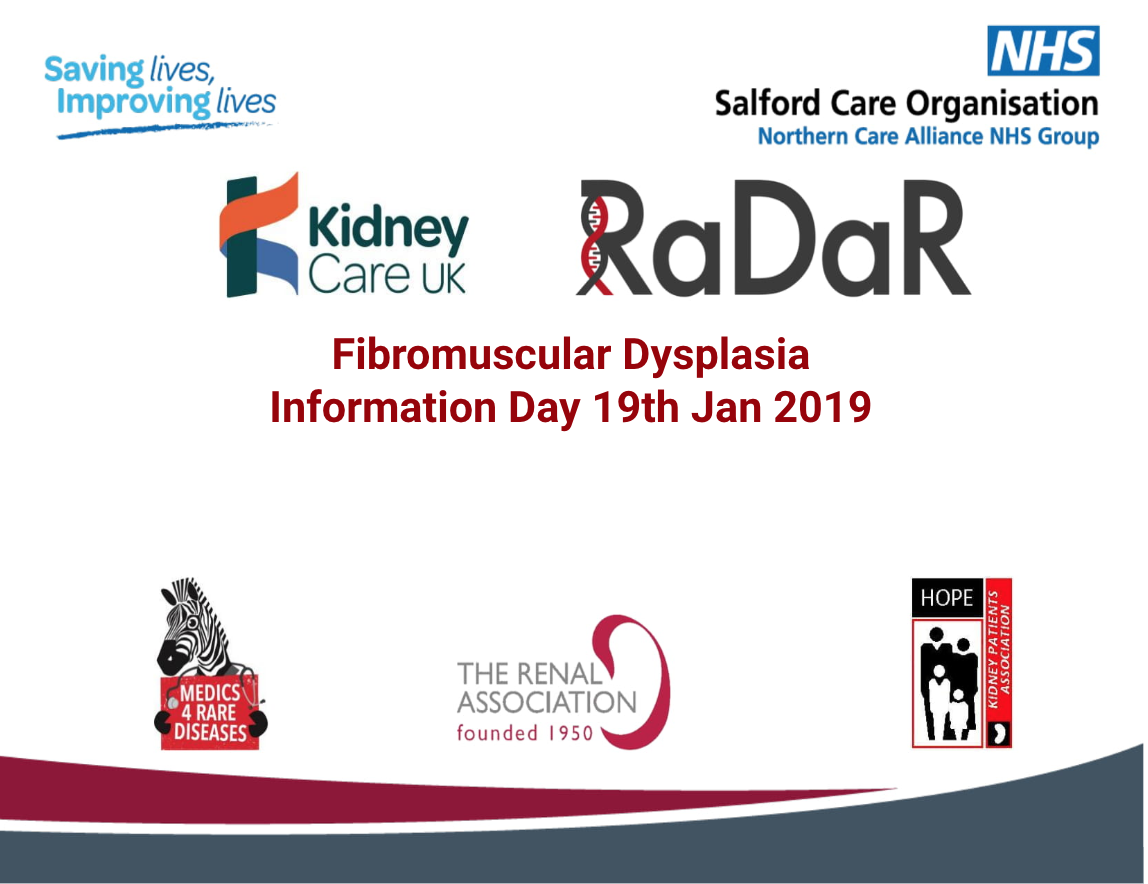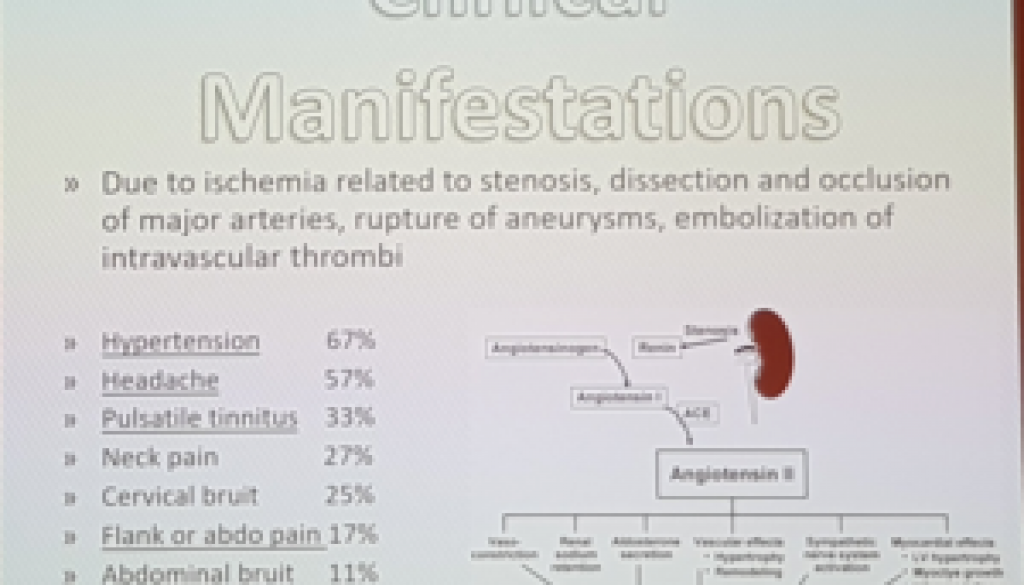The Changing Face of Fibromuscular Dysplasia

Dr Tina Chrysochou is a Consultant Nephrologist at Salford Royal Hospitals NHS Foundation Trust, Honorary Lecturer at the University of Manchester and the incoming president of the Royal Society of Medicine Nephrology section 2018/2019. Ahead of the first patient information day for fibromuscular dysplasia she wants to give medics a snapshot of what this condition is, why its important and her team are trying to improve awareness and care for patients.
Background
Our understanding of fibromuscular dysplasia (FMD) is evolving from a rare disease of renal arteries accounting for a minority of cases of secondary hypertension in young women, to a ‘systemic’ vascular disease which can affect all arterial beds. In FMD one or more arteries in the body demonstrates abnormal cell development in the artery wall. FMD can be found in any arterial bed in the body. It is most commonly found in the renal arteries and the carotid and vertebral arteries.
In the UK FMD has been historically thought to carry a benign prognosis and as a result, research in this area has lagged behind. However, FMD can be associated with severe hypertension, ischaemic or haemorrhagic stroke, myocardial infarction and end stage renal diseases. It can lead to invasive procedures such as percutaneous angioplasty, reconstructive surgery, or intracranial aneurysm clipping. Thus, both the disease and its treatment can lead to significant morbidity and mortality.
What causes FMD?
The pathophysiology and aetiology of fibromuscular dysplasia remain unclear. Some registries have shown up to 10% of cases may be hereditary. Because women have FMD more often than men do, hormones may be linked to the development of FMD. However, FMD is not linked to how many pregnancies women have had, when they give birth or whether they’ve taken birth control pills.
Fibromuscular dysplasia could be caused by inadequate oxygen to the arterial blood vessel wall, which causes the vessels to form abnormally. It could also be caused by abnormally positioned arteries, or if a medication or tobacco causes abnormal arterial development. Once the artery develops abnormally, a cluster of cells builds in the artery wall, narrowing it and reducing blood flow.
Risk Factors
Although the cause of fibromuscular dysplasia is unknown, there are several factors that appear to increase the risk of developing the disorder, including:
•Gender: Women have a much greater risk of fibromuscular dysplasia than men do
•Age: Fibromuscular disorder tends to be diagnosed in people in their early 50s
•Smoking: People who smoke appear to have an increased risk of developing fibromuscular dysplasia. For those already diagnosed with the FMD, smoking is a risk factor for more serious disease
New insights into FMD
FMD is a good example of the importance of patient registries. A patient registry is a collection of specific information about patients who all share a condition and they help us to better understand the natural history of a particular disease. Through information gleaned from patient registries, we are now challenging previously held information on FMD e.g:
-
Common clinical manifestations of FMD are actually more diverse than we had previously thought. For patients in the US FMD registry, hypertension was the most common presenting manifestation (affecting 63.8% of patients). However, other common signs and symptoms included:
-
Headache (52.4%)
-
Pulsatile tinnitus or “swooshing” noise in the ears (27.5%)
-
Dizziness (26%)
-
Cervical bruit (22.2%)
-
Neck pain (22.2%)
-
-
2/3 of patients have arterial bed involvement in addition to major artery disease
-
Men and women present differently:
-
Women outnumber men 9:1 in registries
-
Renal and visceral involvement with dissection and aneurysm is more common in men
-
-
FMD remains under-diagnosed in European and American registries and diagnosis is often delayed
-
The aetiology remains unclear
-
Research is underway, but more is needed to understand how genetics, environmental stressors and hormones may play a role in FMD. This includes uploading data about FMD patients to registries.
The FMD Rare Diseases Registry (RADAR) Specialist Interest Group is aiming to raise awareness and provide advice about the best strategy for the diagnosis and management of this still under-diagnosed disease. Patients with FMD in any arterial bed can be uploaded to FMD RADAR (@RenalRadar on twitter).
FMD Information Day
We have linked up with a patient group who have formed the FMD Society of UK and Ireland (@FmdsUK). The UK’s first patient information day on FMD will be held on 19th January 2019 at Salford Royal Hospital. Although, this day has been designed with patients in mind it is still relevant to medical students and doctors in training as it will aim to explain what FMD is, challenge previous misconceptions about FMD and highlight the latest work being undertaken by registries and research.
Come and hear from expert international guest speakers such as Professor Alexandre Persu (Lead for The European FMD registry) and Professor David Adlam (UK expert in spontaneous coronary artery dissection (SCAD)). As well as celebrity chef and FMD/SCAD sufferer, Sally Bee! This day will be of interest to clinicians, patients and carers alike.
Any further information, contact tina.chrysochou@srft.nhs.uk or @FmdsUK on twitter. Information about this event will be kept up-to-date on our events page.
References:
-
O’Connor S, Olin JW, Gornik HL. Top 8 Lessons Learned From the US Registry for FMD. Understanding the impact of registry data on clinical practice. https://evtoday.com/2014/02/top-8-lessons-learned-from-the-us-registry-for-fmd/
-
Persu A, Giavarini A, et al. European consensus on the diagnosis and management of fibromuscular dysplasia. Journal of Hypertension. 32(7):1367–1378, Jul 2014
-
Olin JW, Froehlich J, Gu X, et al. The United States registry for fibromuscular dysplasia: results in the first 447 patients. Circulation. 2012;125:3182-3190.
-
Kim ESH, Olin JW, Froehlich JB, et al. Clinical manifestations of fibromuscular dysplasia vary by patient sex: a report of the United States registry for fibromuscular dysplasia. J Am Coll Cardiol. 2013;61:2026-2028




